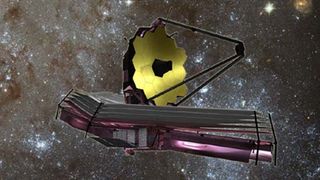
The delays and billion-dollar cost overruns afflicting NASA's next-generation space telescope stem from long-standing budgeting and management problems that began nearly a decade ago, an independent review panel has found.
NASA's James Webb Space Telescope can launch no earlier than September 2015 and will cost at least $6.5 billion, the panel concluded in a report released yesterday (Nov. 10). That puts the telescope ? billed as the muscular successor to NASA's Hubble Space Telescope ? at least $1.5 billion over budget and more than a year behind schedule.
In a piece of good news, the panel found no fault with JWST's scientific progress, instead hailing its promise to become the world's next great space observatory.
"It has to do with the management and budgetary aspects of the project, not the technical aspects," panel chair John Casani, of NASA's Jet Propulsion Laboratory, told reporters yesterday. "There was just not enough money in the budget to execute the work required."
Problems at the start
The James Webb Space Telescope, led by NASA's Goddard Space Flight Center in Greenbelt, Md., has huge light-collecting power. Its primary mirror is 21 feet (6.5 meters) wide ? more than twice as big as Hubble's.
While orbiting about 1 million miles (1.6 million kilometers) from Earth, JWST will scan the universe in infrared light, helping astronomers study the early days of the universe, the formation of alien star systems and much more, NASA officials have said.
Get the Space.com Newsletter
Breaking space news, the latest updates on rocket launches, skywatching events and more!
"James Webb is a hugely more powerful facility than Hubble," said review panel member Garth Illingworth of the University of California Observatories. "It's 100 times more powerful, at least."
For its report, the review panel only considered what has gone wrong with the JWST project since 2008, when the telescope passed all of its preliminary design reviews and NASA formally committed to build it.
But the project has been underpriced from its inception, the panelists said.
JWST was named the top research priority by the 2001 astronomy and astrophysics decadal survey, a report put out every 10 years by the U.S. National Research Council.
The decadal survey pegged JWST's total cost at around $1 billion. While such a number may never have been achievable ? decadal surveys have issued some overly rosy budget prognostications through the years ? JWST's costs have undeniably exploded.
In its budget request for fiscal year 2011, NASA estimated the telescope would cost $5 billion over its lifetime, from design and development through the end of its operational life.
The space agency requested $445 million for JWST just for 2011. The telescope eats up about 40 percent of NASA's astrophysics division budget by itself, according to the review panel.
What went wrong?
Costs have continued to rise because the budget ? the one the JWST project office gave to NASA when it officially committed to build the telescope in 2008 ? was too low, Casani said. And the problem was never fixed because NASA headquarters didn't realize there was a problem.
These issues are indicative of broader problems, the review panel concluded.
"The institutional cost and program analysis capability at the Directorate and Agency level continues to function without the skill and authority required," Casani wrote in a letter to NASA Administrator Charles Bolden after the panel completed its review. "Demand for corrective action was absent, and poor management practices on the JWST Project went unquestioned for too long."
While the panel said that there was no way to reduce JWST's price tag below $6.5 billion at this point, it issued several recommendations to make the project leaner and more efficient in the future.
The panel suggested, for example, that the JWST program be restructured to improve accounting of costs and risks, and to give NASA's associate administrator stronger oversight capabilities.
NASA officials said they will take the panel's findings to heart, and that they have already implemented some of the recommendations.
"The report was very helpful in pointing out our flaws, and we intend to fix those," said Chris Scolese, NASA associate administrator. "We welcome the attention and the involvement."
Scolese added that NASA has already reorganized JWST, elevating it to a program that will report directly to him ? and that JWST team members will do so several times per week. And he said that NASA's Bolden is fully briefed and actively involved.
"The administrator is taking this very seriously," Scolese said.
Despite JWST's problems, the panel lauded the telescope's tremendous scientific potential, stressing that it will provide huge payoffs once it gets off the ground.
"This is an absolutely outstanding technical and scientific endeavor," Casani said. "This is a tough job, but it's just the kind of job NASA was created for, and just the kind of job NASA should be doing."
- NASA's Next Big Space Telescope to Cost an Extra $1.5 Billion
- Images: 20 Years of the Hubble Space Telescope
- Bigger, Better Space Telescopes Following in Hubble's Footsteps
Join our Space Forums to keep talking space on the latest missions, night sky and more! And if you have a news tip, correction or comment, let us know at: community@space.com.

Michael Wall is a Senior Space Writer with Space.com and joined the team in 2010. He primarily covers exoplanets, spaceflight and military space, but has been known to dabble in the space art beat. His book about the search for alien life, "Out There," was published on Nov. 13, 2018. Before becoming a science writer, Michael worked as a herpetologist and wildlife biologist. He has a Ph.D. in evolutionary biology from the University of Sydney, Australia, a bachelor's degree from the University of Arizona, and a graduate certificate in science writing from the University of California, Santa Cruz. To find out what his latest project is, you can follow Michael on Twitter.
